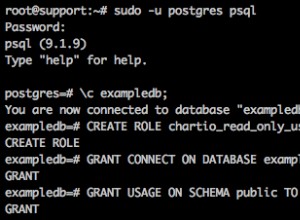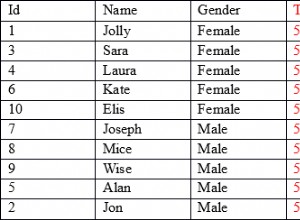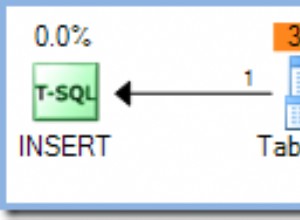So sehen die möglichen Überlappungen aus, wobei „A“ das „Referenz“-Intervall ist. Beachten Sie, dass die Abfrage unten (weit, weit unten) nicht das gleiche Ergebnis liefert wie die bisher geposteten Antworten.
-- A |------|
-- B |-|
-- C |---|
-- D |---|
-- E |---|
-- F |---|
-- G |---|
-- H |---|
-- I |---|
"B" überschneidet sich überhaupt nicht mit "A". "C" grenzt daran. {"D", "E", "F", "G"} überlappt es. "H" grenzt daran. "I" überlappt es überhaupt nicht.
create table calls_nov (
sid varchar(5) primary key,
starttime timestamp not null,
endtime timestamp not null
);
insert into calls_nov values
('A', '2012-01-04 08:00:00', '2012-01-04 08:00:10'),
('B', '2012-01-04 07:50:00', '2012-01-04 07:50:03'),
('C', '2012-01-04 07:59:57', '2012-01-04 08:00:00'),
('D', '2012-01-04 07:59:57', '2012-01-04 08:00:03'),
('E', '2012-01-04 08:00:01', '2012-01-04 08:00:04'),
('F', '2012-01-04 08:00:07', '2012-01-04 08:00:10'),
('G', '2012-01-04 08:00:07', '2012-01-04 08:00:13'),
('H', '2012-01-04 08:00:10', '2012-01-04 08:00:13'),
('I', '2012-01-04 08:00:15', '2012-01-04 08:00:18');
Sie können alle überlappenden Intervalle so sehen. (Ich habe nur to_char() verwendet, um es einfach zu machen, alle Daten zu sehen. Sie können es in der Produktion weglassen.)
select t1.sid, to_char(t1.starttime, 'HH12:MI:SS'),
to_char(t1.endtime, 'HH12:MI:SS'),
t2.sid, to_char(t2.starttime, 'HH12:MI:SS'),
to_char(t2.endtime, 'HH12:MI:SS')
from calls_nov t1
inner join calls_nov t2 on (t2.starttime, t2.endtime)
overlaps (t1.starttime, t1.endtime)
order by t1.sid, t2.sid;
A 08:00:00 08:00:10 A 08:00:00 08:00:10
A 08:00:00 08:00:10 D 07:59:57 08:00:03
A 08:00:00 08:00:10 E 08:00:01 08:00:04
A 08:00:00 08:00:10 F 08:00:07 08:00:10
A 08:00:00 08:00:10 G 08:00:07 08:00:13
B 07:50:00 07:50:03 B 07:50:00 07:50:03
C 07:59:57 08:00:00 C 07:59:57 08:00:00
C 07:59:57 08:00:00 D 07:59:57 08:00:03
D 07:59:57 08:00:03 A 08:00:00 08:00:10
D 07:59:57 08:00:03 C 07:59:57 08:00:00
D 07:59:57 08:00:03 D 07:59:57 08:00:03
D 07:59:57 08:00:03 E 08:00:01 08:00:04
E 08:00:01 08:00:04 A 08:00:00 08:00:10
E 08:00:01 08:00:04 D 07:59:57 08:00:03
E 08:00:01 08:00:04 E 08:00:01 08:00:04
F 08:00:07 08:00:10 A 08:00:00 08:00:10
F 08:00:07 08:00:10 F 08:00:07 08:00:10
F 08:00:07 08:00:10 G 08:00:07 08:00:13
G 08:00:07 08:00:13 A 08:00:00 08:00:10
G 08:00:07 08:00:13 F 08:00:07 08:00:10
G 08:00:07 08:00:13 G 08:00:07 08:00:13
G 08:00:07 08:00:13 H 08:00:10 08:00:13
H 08:00:10 08:00:13 G 08:00:07 08:00:13
H 08:00:10 08:00:13 H 08:00:10 08:00:13
I 08:00:15 08:00:18 I 08:00:15 08:00:18
Sie können aus dieser Tabelle ersehen, dass "A" 5 zählen sollte, einschließlich sich selbst. "B" sollte 1 zählen; es überlappt sich selbst, aber keine anderen Intervalle überlappen es. Das scheint das Richtige zu sein.
Das Zählen ist einfach, läuft aber wie eine geplatzte Schildkröte. Das liegt daran, dass die Bewertung einer Überlappung viel Arbeit erfordert.
select t1.sid, count(t2.sid) as num_concurrent
from calls_nov t1
inner join calls_nov t2 on (t2.starttime, t2.endtime)
overlaps (t1.starttime, t1.endtime)
group by t1.sid
order by num_concurrent desc;
A 5
D 4
G 4
E 3
F 3
H 2
C 2
I 1
B 1
Um eine bessere Leistung zu erzielen, können Sie die obige "Tabelle" in einem allgemeinen Tabellenausdruck verwenden und basierend auf diesem zählen .
with interval_table as (
select t1.sid as sid_1, t1.starttime, t1.endtime,
t2.sid as sid_2, t2.starttime, t2.endtime
from calls_nov t1
inner join calls_nov t2 on (t2.starttime, t2.endtime)
overlaps (t1.starttime, t1.endtime)
order by t1.sid, t2.sid
)
select sid_1, count(sid_2) as num_concurrent
from interval_table
group by sid_1
order by num_concurrent desc;




